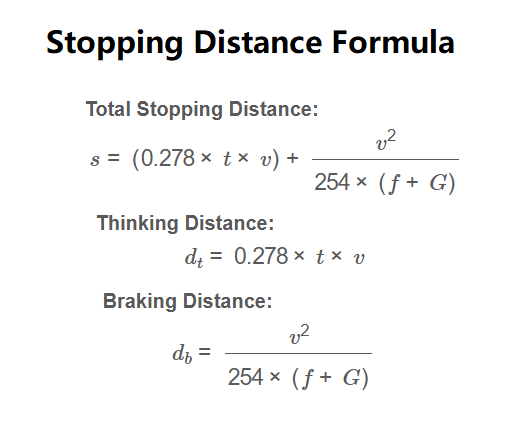1. What is a Stopping Distance Calculator (AASHTO)?
Definition: This calculator determines the total stopping distance of a vehicle using the AASHTO formula, which includes the thinking distance (during perception-reaction time) and the braking distance (considering friction and road grade).
Purpose: It is used in automotive safety, road design, and driver education to estimate how far a vehicle travels before stopping, ensuring safe driving distances and effective road engineering.
2. How Does the Calculator Work?
The calculator uses the AASHTO stopping distance formula:
Total Stopping Distance:
\[
s = (0.278 \times t \times v) + \frac{v^2}{254 \times (f + G)}
\]
Thinking Distance:
\[
d_t = 0.278 \times t \times v
\]
Braking Distance:
\[
d_b = \frac{v^2}{254 \times (f + G)}
\]
Where:
- \(s\): Total stopping distance (m)
- \(d_t\): Thinking distance (m)
- \(d_b\): Braking distance (m)
- \(v\): Speed (km/h)
- \(t\): Perception-reaction time (s)
- \(f\): Coefficient of friction (unitless)
- \(G\): Road grade (decimal, positive for uphill, negative for downhill)
Unit Conversions:
- Speed: km/h, m/s (1 m/s = 3.6 km/h), mph (1 mph = 1.609344 km/h), kn (1 kn = 1.852 km/h)
- Time: s, ms (1 s = 1000 ms)
- Distance: m, ft (1 ft = 0.3048 m), km (1 km = 1000 m), mi (1 mi = 1609.344 m)
Steps:
- Enter the initial speed (v), selecting the unit (km/h, m/s, mph, kn)
- Enter the perception-reaction time (t), selecting the unit (s, ms)
- Select the road condition (Dry: \(f = 0.7\), Wet: \(f = 0.35\), or Custom)
- If Custom, enter the coefficient of friction (f)
- Enter the road grade (G) as a decimal
- Convert speed to km/h and time to seconds
- Calculate thinking distance, braking distance, and total stopping distance
- Select the desired unit for each distance result and view the converted values
3. Importance of Stopping Distance Calculation
Calculating stopping distance is crucial for:
- Safety: Ensuring drivers maintain safe distances to avoid collisions.
- Road Design: Designing roads with appropriate signage and speed limits based on stopping distances.
- Education: Teaching drivers about the impact of speed, reaction time, and road conditions on stopping distance.
What is the stopping distance on a dry road?
On a dry road, the stopping distances are the following:
| Speed |
Stopping Distance |
| 10 mph |
41 ft (13 m) |
| 20 mph |
93 ft (28 m) |
| 30 mph |
153 ft (47 m) |
| 40 mph |
223 ft (68 m) |
| 50 mph |
302 ft (92 m) |
| 60 mph |
392 ft (120 m) |
| 70 mph |
491 ft (150 m) |
What is the stopping distance on a wet road?
On a wet road, the stopping distances are the following:
| Speed |
Stopping Distance |
| 10 mph |
43 ft (13 m) |
| 20 mph |
107 ft (32 m) |
| 30 mph |
195 ft (59 m) |
| 40 mph |
311 ft (95 m) |
| 50 mph |
457 ft (139 m) |
| 60 mph |
636 ft (194 m) |
| 70 mph |
849 ft (259 m) |
4. Using the Calculator
Examples:
- Example 1 (Dry Road, Flat): For an initial speed \( v = 100 \, \text{km/h} \), reaction time \( t = 1.5 \, \text{s} \), road condition Dry (\( f = 0.7 \)), grade \( G = 0 \):
- Thinking distance: \( d_t = 0.278 \times 1.5 \times 100 = 41.700 \, \text{m} \)
- Braking distance: \( d_b = \frac{100^2}{254 \times (0.7 + 0)} = \frac{10000}{177.8} \approx 56.242 \, \text{m} \)
- Total stopping distance: \( s = 41.700 + 56.242 \approx 97.942 \, \text{m} \)
- With units: \( d_t = 41.700 \, \text{m} \), \( d_b = 184.520 \, \text{ft} \), \( s = 0.098 \, \text{km} \)
- Example 2 (Wet Road, Uphill): For an initial speed \( v = 60 \, \text{mph} \), reaction time \( t = 1500 \, \text{ms} \), road condition Wet (\( f = 0.35 \)), grade \( G = 0.05 \):
- Speed: \( 60 \cdot 1.609344 = 96.561 \, \text{km/h} \)
- Reaction time: \( 1500 \cdot 0.001 = 1.5 \, \text{s} \)
- Thinking distance: \( d_t = 0.278 \times 1.5 \times 96.561 \approx 40.242 \, \text{m} \)
- Braking distance: \( d_b = \frac{96.561^2}{254 \times (0.35 + 0.05)} = \frac{9323.988}{101.6} \approx 91.772 \, \text{m} \)
- Total stopping distance: \( s = 40.242 + 91.772 \approx 132.014 \, \text{m} \)
- With units: \( d_t = 132.002 \, \text{ft} \), \( d_b = 0.092 \, \text{km} \), \( s = 0.082 \, \text{mi} \)
5. Frequently Asked Questions (FAQ)
Q: What is the AASHTO stopping distance formula?
A: The AASHTO formula is \( s = (0.278 \times t \times v) + \frac{v^2}{254 \times (f + G)} \), combining thinking and braking distances based on speed, reaction time, friction, and road grade.
Q: How does road grade affect stopping distance?
A: An uphill grade (\(G > 0\)) reduces stopping distance by assisting deceleration, while a downhill grade (\(G < 0\)) increases it by opposing deceleration.
Q: Why does wet road condition increase stopping distance?
A: Wet conditions reduce the coefficient of friction (\(f\)), decreasing deceleration and thus increasing the braking distance.
Stopping Distance Calculator (AASHTO)© - All Rights Reserved 2025
 Home
Home
 Back
Back
